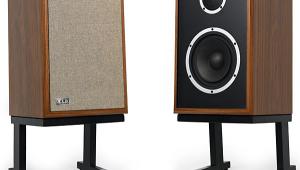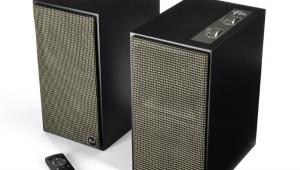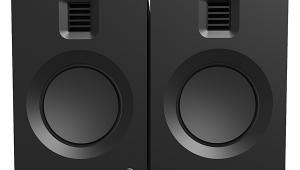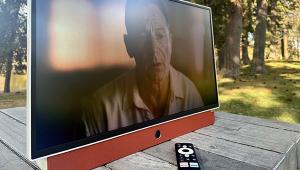I agree that this disc is nothing to crow about. To me it lacked any dynamics that a rock disc should have. I did not like the mix in some cases particulaly when a singing voice comes out other than the center. I did find the separation was quite good and heard center back sound as well.
Morel SoundSpot Music Theatre 2 Ultra Speaker System
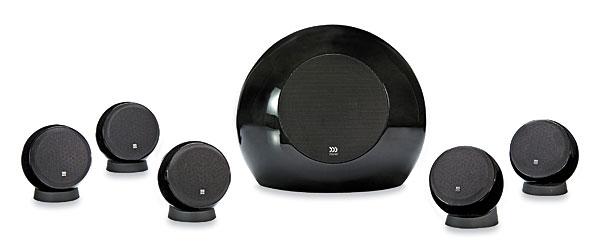
Life is full of strange synchronicities. Around the time my friends in the country were posting pictures of their spring mushroom harvests on Facebook, I just happened to be setting up Morel’s SoundSpot Music Theatre 2 Ultra, a 5.1-channel satellite/subwoofer set based on the adorably spherical SP-2 sat and PSW10 sub. Would Morels in my system sound as good as morels taste on pizza? In omelets or pasta? With steak or veal? With asparagus? In wine or cream sauces? In gravy?
The Morel SoundSpot SP-2 satellite is a steel sphere...
Wait, what about morel quiche? Just sayin’.
Heavenly Spheres
The Morel SoundSpot SP-2 satellite is a steel sphere 5.5 inches
in diameter and 1 millimeter thick. Knuckle-rapped, it sounds commendably inert—the enclosure doesn’t add a note of its own. In both the satellite and the subwoofer, the rounded shape prevents standing waves from bouncing back and forth between parallel surfaces inside the cabinet. This eliminates a problem associated with box speakers that can cause sound muddying.
While the spherical enclosure might seem ideal for a single full-range driver, two are squeezed into it, with the 0.75-inch textiledome tweeter mounted in the center of the 4-inch cellulosefiber paper-coned woofer. This coaxial array lets the output of the two drivers act more like a single point source. In other words, the off-axis response will likely be more consistent at all listening positions, resulting in a larger sweet spot.

The downside of coaxial arrays in general is that the physical presence of each driver may interact with (that is, get in the way of) the other driver’s wave launch, causing a cupped-hands coloration. In my review of Morel’s Nova sat/sub system [Home Theater, January 2005], I heard “no particular nasality—just a tubey warmth.” This newer product seems to have reduced what I call the “coaxial coloration” to the point where I was unaware of it most of the time.
A few other differences between the newer and older products: I described the Nova as a “half sphere.” The SP-2 is more like two-thirds of a sphere, hacked off in front for a cloth-covered baffle.

The binding posts have given way to screw-type speaker terminals, a round plastic plate with two sets of holes, one set for cable tips, the other for hex screws. Push in the cable tips and tighten the screws with the included Allen wrench. Easy peasy.
The pedestal has been reshaped into a two-piece plastic assembly in which the speaker-terminal part slides within tracks. The tracks are a tight fit—eliminating any possibility of rattling or buzzing. You can loosen their grip just enough to make adjustments by rotating the speaker as you slide it across the pedestal. The range of adjustment is 270 degrees horizontal by 90 degrees vertical. This clever arrangement enables on-wall, on-ceiling, or on-shelf placement without the need for additional accessories.
Then there’s the PSW10 subwoofer. Its round-vented fiberglass composite resin enclosure is a flattened sphere with a metal grille on front for its single 10-inch driver and a beautifully molded port in back. As best I can remember, this is the first time I’ve described a port as beautiful. Morel rates the sub down to 25 hertz; as always, see HT Labs Measures. The difference between the SoundSpot Music Theatre 2 Ultra reviewed here and the non-Ultra version is that the latter has a smaller sub (8 inches instead of 10) with half as much power (100 watts continuous instead of 200).
Associated equipment included a Rotel RSX-1550 A/V receiver and OPPO BDP-83SE universal disc player.
Fascinating
The J.J. Abrams remake of Star Trek gave the Morels their trial
by intergalactic fire. In the effects-heavy scenes that set
up the character studies of
Kirk and Spock, the old task
of reconciling the volumes of effects with dialogue was reasonably straightforward—especially since I already knew the story—so adjustments were few and minimal. I’ve always liked the way certain scenes of this movie abruptly throttle back the effects to let the orchestra interpret the action. In general, the 6-ohm-rated satellites liked more power than most speakers of their size, often requiring a higher than usual setting of the Rotel’s volume control. Vocals were both clear and natural sounding—and just a touch on the warm side. Coaxial coloration was so subtle that, had I not been listening for
it based on my knowledge of the design, I might not have heard
it. Off-axis response was superb: These speakers weren’t beamy, and I could move around the sofa freely without the soundfield collapsing.
All Good Things skillfully mines a real-life missing-persons case for speculation and drama, with a top-flight cast that includes Ryan Gosling as the tormented husband, Kirsten Dunst as the ill-fated wife, and Frank Langella as a hard-charging real estate mogul. This time, voices were “startlingly detailed,” my notebook reminds me, “fully filled out, not reticent or gauzy.” My reaction to the score’s strings was much the same. While heightened detail often brings fatigue, that didn’t happen in this case. The speakers were virtuosos when delivering rain (as I’ve said before, my favorite surround effect). They drew strong distinctions between a soft wraparound rain that establishes mood and a harder pattering rain that briefly drenches a character, making me feel empathetically wet.

Secretariat and its racetracks formed a surround wonderland. The open-air ambience was alive with echoing PA systems, the distant suggestion of a brass band, and then (of course) with the twin roars of the pounding hooves and the excited crowd. All of that was strongly and tightly imaged, with no gaps or weak spots in the soundfield. Identical speakers all around can conjure a potent soundfield. When the speakers operate with coaxial near-point-source precision, you get even more of a good thing. The PSW10 sub managed to keep its cool under the onslaught of thundering hooves. Nestled in its rounded enclosure, the driver could convey aggressive bass content without bloating.
Best-Case Scenario
While movie demos usually
leave me with a variety of impressions, it’s music—especially music recorded in high-resolution surround with acoustic instruments—that really helps me
put it all together. I thought the Morels were pretty good up to
the end of the movie sessions,
but it wasn’t until the start of the music sessions that they hit their stride.
Best-case demo material arrived in the form of Schubert’s Symphony No. 9 in C (The Great) with the Royal Flemish Philharmonic conducted by Philippe Herreweghe. PentaTone recorded it just last year at Antwerp’s Queen Elizabeth Hall and released it as a hybrid SACD—so to those who say SACD is dead and multichannel music never caught on, I say, wash out your mouth with soap. While I like having the CD-layer option, the SACD layer was what filled my room with Schubert’s joyful confidence, marred only by the recording’s slight underuse of the center channel (which was active, but faintly).
The coloration I just barely noticed with vocals vanished altogether with well-recorded strings. They had well-developed high-frequency extension, plenty of midrange detail, and even a bit of bite—but not the kind that would make me cut the volume. Brass instruments were fully filled out. The end result was as close to being in a concert hall as any multichannel orchestral demo I’ve heard. My pen went berserk: “Exceptional. Best-of-breed performance.” No, this little system didn’t have the top-to-bottom perfection of a chunky stand-mount rig operating with a lower crossover point. But it reached well into the potential of its category, and as I often say, compact sat/sub sets are an underrated category.
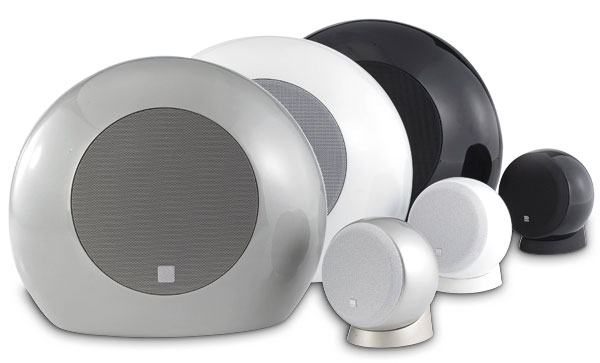
Josh One’s Narrow Path is a 2004 DualDisc. This ill-fated format attempted to combine DVD-Audio and CD on opposite sides of the same disc but foundered with fainthearted marketing and mechanical problems. My OPPO had no trouble extracting the lossless surround mix from the DVD-Audio side. And what a mix it is. The artist and his creative team seemed to revel in the possibilities of 5.1 in this eclectic mix of songs alternating between rap/R&B vocals and instrumentals. While the instrumental tracks bounced some elements into the surrounds, the vocally centered tracks exercised more restraint, using the surrounds only to pull elements slightly toward the listening position, no more than a couple of feet in front of the left/center/right speakers. This fattened the front soundstage while maintaining an invisible proscenium. The sub did a fine job with the rhythm section—and with the 120-Hz crossover that the satellites’ limited bass response demanded. It shouldered a large share of the work, especially in one instrumental with a phat groove.
I descended from vintage surround heaven into vintage surround hell with Days of Future Passed by the Moody Blues, on 5.1-channel old-school DTS-encoded CD, circa 1997. Frankly, I’ve always found the album drippy and pretentious—aside from “Nights in White Satin,” Justin Hayward’s signature tune, and his lovely “Forever Afternoon (Tuesday?).” But the attempt to transform this album to multichannel just made it worse. The soundfield was disorientingly diffuse. And the lossy surround encoding made the orchestral strings so strident, I groped for the remote in a panic. No fault of the speakers. They were just being truthful.
The Morel SoundSpot Music Theatre 2 Ultra speaker system may raise an eyebrow among those who don’t think of compact satellite/subwoofer sets as $2,199 products. But the top specimens of any genre generally command high prices. And these well-made, musically satisfying, cinematically potent speakers make a convincing case not only for themselves but for their genre. Little speakers can sound amazing.
- Log in or register to post comments



From my perspective, the best use of surround when mixing music is to reinforce the sound of the stereo and to create a sense of space. Sometimes it's fun to have an effect move from the front to the back but in general, gimmicks like sticking the vocals in the back of the room or moving main instruments around in circles or taking a secondary part and sticking it in the surround always work to the detriment of the music.

Hey Mark,
Bluntly, Morel or Goldenear? You reviewed both of these almost back to back and with the some of the same materials.
Less bluntly, can you summarize the basic differences between these two recently reviewed speaker systems?


